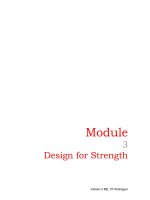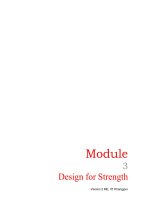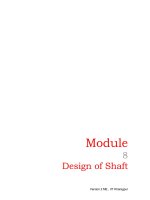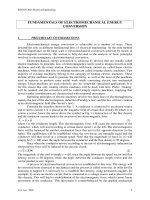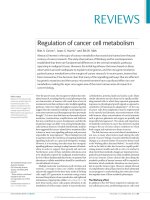FUNDAMENTALS OF ESTHETIC IMPLANT DENTISTRY docx
Bạn đang xem bản rút gọn của tài liệu. Xem và tải ngay bản đầy đủ của tài liệu tại đây (10.97 MB, 355 trang )
FUNDAMENTALS OF ESTHETIC
IMPLANT DENTISTRY
Abd El Salam El Askary
FUNDAMENTALS OF ESTHETIC IMPLANT DENTISTRY
FUNDAMENTALS OF ESTHETIC
IMPLANT DENTISTRY
Abd El Salam El Askary
Dr. Abd El Salam El Askary maintains a private practice special-
izing in esthetic dentistry in his native Egypt. An experienced cli-
nician and researcher, he is also very active on the international
conference circuit and as a lecturer on continuing professional
development courses. He also holds the position of Associate
Clinical Professor at the University of Florida, Jacksonville.
© 2007 by Blackwell Munksgaard,
a Blackwell Publishing Company
Editorial Offices:
Blackwell Publishing Professional,
2121 State Avenue, Ames, Iowa 50014-8300, USA
Tel: +1 515 292 0140
9600 Garsington Road, Oxford OX4 2DQ
Tel: 01865 776868
Blackwell Publishing Asia Pty Ltd,
550 Swanston Street, Carlton South,
Victoria 3053, Australia
Tel: +61 (0)3 9347 0300
Blackwell Wissenschafts Verlag, Kurfürstendamm 57, 10707 Berlin,
Germany
Tel: +49 (0)30 32 79 060
The right of the Author to be identified as the Author of this Work
has been asserted in accordance with the Copyright, Designs and
Patents Act 1988.
All rights reserved. No part of this publication may be reproduced,
stored in a retrieval system, or transmitted, in any form or by any
means, electronic, mechanical, photocopying, recording or other-
wise, except as permitted by the UK Copyright, Designs and
Patents Act 1988, without the prior permission of the publisher.
First published 2007 by Blackwell Munksgaard, a Blackwell
Publishing Company
Library of Congress
Cataloging-in-Publication Data
El Askary, Abd El Salam.
Fundamentals of esthetic implant dentistry / Abd El Salam El
Askary. – 2nd ed.
p. ; cm.
Rev. ed. of: Reconstructive aesthetic implant surgery. c2003.
Includes bibliographical references and index.
ISBN-13: 978-0-8138-1448-3 (alk. paper)
ISBN-10: 0-8138-1448-0 (alk. paper)
1. Dental implants. I. El Askary, Abd El Salam.
Reconstructive aesthetic implant surgery. II. Title.
[DNLM: 1. Dental Implantation–methods. 2. Esthetics,
Dental. 3. Reconstructive Surgical Procedures–methods.
WU 640 E37f 2007]
RK667.I45E4 2007
617.6′92–dc22
2006027645
978-0-8138-1448-3
Set in 9.5/12.5 pt Palatino
by SNP Best-set Typesetter Ltd., Hong Kong
Printed and bound by C.O.S. Printers Pte. Ltd.
For further information on
Blackwell Publishing, visit our website:
www.blackwellpublishing.com
Disclaimer
The contents of this work are intended to further general scientific
research, understanding, and discussion only and are not intended
and should not be relied upon as recommending or promoting a
specific method, diagnosis, or treatment by practitioners for any
particular patient. The publisher and the editor make no represen-
tations or warranties with respect to the accuracy or completeness
of the contents of this work and specifically disclaim all warranties,
including without limitation any implied warranties of fitness for
a particular purpose. In view of ongoing research, equipment mod-
ifications, changes in governmental regulations, and the constant
flow of information relating to the use of medicines, equipment,
and devices, the reader is urged to review and evaluate the infor-
mation provided in the package insert or instructions for each med-
icine, equipment, or device for, among other things, any changes
in the instructions or indication of usage and for added warnings
and precautions. Readers should consult with a specialist where
appropriate. The fact that an organization or Website is referred to
in this work as a citation and/or a potential source of further infor-
mation does not mean that the author or the publisher endorses
the information the organization or Website may provide or rec-
ommendations it may make. Further, readers should be aware that
Internet Websites listed in this work may have changed or disap-
peared between when this work was written and when it is read.
No warranty may be created or extended by any promotional state-
ments for this work. Neither the publisher nor the author shall be
liable for any damages arising herefrom.
The last digit is the print number: 987654321
I dedicate this work to the one who teacheth by the pen, Teacheth man that which he knew not.
Contents
List of Contributors, viii
Foreword, ix
Preface, x
Acknowledgments, xii
About the Author, xiv
Chapter 1 Introduction, 3
Chapter 2 Diagnostic Considerations for Esthetic Implant Therapy, 13
Chapter 3 Contemporary Facial Evaluation, 79
Chapter 4 Multidimensional Esthetic Implant Positioning, 109
Chapter 5 Intraoral Plastic Soft Tissue Surgery, 127
Chapter 6 Immediate Esthetic Implant Therapy, 179
Chapter 7 Socket Augmentation: Rationale and Technique, 209
Chapter 8 The Interimplant Papilla, 225
Chapter 9 Tissue Engineering in Maxillofacial Surgery, 255
Chapter 10 Prosthetic Technologies and Techniques Beyond the Mere Fixture, 263
Chapter 11 The Art and Science of Shade Matching in Esthetic Implant Dentistry, 275
Chapter 12 Treatment Complications in the Esthetic Zone, 301
Index, 329
vii
List of Contributors
Main author:
Abd El Salam El Askary, B.D.S
39 Abdelsalam aref. St.
Elbostan
Alexandria, Egypt
E-mail:
Phone: +2 012 214 8642
Fax: +2 03 5850770
Co-authors:
Chapter 7
Hom-Lay Wang, D.D.S., M.S.D.
Professor and Director of Graduate Periodontics
Department of Periodontics and Oral Medicine
University of Michigan School of Dentistry
1011 North University Avenue
Ann Arbor, Michigan 48109-1078, USA
Phone: 734-763-3383
Fax: 734-936-0374
E-mail:
Rodrigo F. Neiva, D.D.S.
Clinical Assistant Professor
Department of Periodontics and Oral Medicine
University of Michicgan School of Dentistry
Ann Arbor, Michigan 48109-1078, USA
viii
Chapter 9
Dr. Dritan Turhani
AKH-General Hospital of Vienna
Department of Cranio-Maxillofacial and Oral Surgery
Waehringer Guertel 18-20
1090 Vienna, Austria
E-mail:
Elisabeth Stein, Martina Weinβenböck, and Rolf Ewers
also contributed
Chapter 10
Dr. Peter Gehrke
Bismarck str.27
67059 Ludwigshafen
Germany
Phone: 49 62 21 68124456
Fax: +49 621 68124469
Email:
Chapter 11
Stephen J. Chu, DMD, MSD, CDT, MDT
150 East 58th Street, Suite 3200
New York, New York 10155
Phone: 212-752-7937
Fax: 212-980-9647
E-mail1:
E-mail2:
Osseointegration is no longer a possibility but rather
a given in implant dentistry today. However, with this
predictability that we have come to expect, has also
come a shift into concerns that at one time were not
even thought about. Today, the concept of beauty and
esthetics are also equally as important as the pure
function of mastication. In fact, in some cases with
high smile lines, it is more important than just func-
tion and will in fact determine the treatment plan of
choice.
This textbook is a wonderful accumulation of the
thoughts and work of Dr. El Askary and other profes-
sionals from around the world. I want to congratulate
Dr. El Askary for his dedication to this project, which is
considered to be an ongoing work in progress over his
outstanding career. His involvement with esthetics and
implant dentistry is as intense as anyone’s in this field,
and his dedication and pursuit of excellence is to be
commended.
This textbook has many wonderful chapters for both
the specialist as well as the novice in this field. It is pre-
sented in a clear meaningful way that all clinicians can
relate to easily. Many of the latest concepts have been
put into this work, some of which have not been seen in
print before. It is also wonderful to see the fact that facial
esthetics and smile analysis has been integrated into the
evaluation of the patient. This is something that dentists
often forget about, and Dr. El Askary has made sure to
emphasize the face and mouth as part of the stage that
is set up for the teeth and intraoral tissues.
In addition, the chapters on modern diagnostic
methods, perioplastic surgery, socket preservation,
papilla regeneration, and bone reconstruction are all
beautifully illustrated and documented. The scientific
community and those involved in esthetic treatment of
their patients will have a sense of fulfillment after
viewing this text. It will be a reference text that will
guide them to improve their performance and to help
solve the clinical dilemmas that they face daily.
Congratulations again to Dr. El Askary, whose dedi-
cation and pursuit of excellence is to be applauded.
Dennis Tarnow
Professor and Chairman
Department of Periodontology and Implant Dentistry
New York University College of Dentistry
Foreword
ix
In the name of God, the Beneficent, and the Merciful.
Implant dentistry today focuses more on the patient’s
overall appearance than ever before, contributing not
only to enhanced social interaction but also to self-
confidence and self-esteem. As a result, esthetic implan-
tology procedures are expected to become a more
integral part of modern dentistry, encompassing quality
of life along with routine functional establishment.
Bennett and Weyant (1993) caution, however, that
overall improvement in oral and facial esthetics may
improve the patient’s social ease, but it may not alter
others’ perceptions of his or her honesty, virtue, help-
fulness, potency, or general emotional adjustment.
Implant dentistry offers a unique opportunity for
collaboration and interaction among clinicians. This is
witnessed by the numerous study groups and specialty
conferences held on an almost weekly basis around the
world. The growth of implant therapy has influenced
almost every aspect of dentistry, from manufacturing
implant components to marketing and financing strate-
gies that further promote implant therapy.
These in turn lead to new loading concepts, versatile
restorative options, challenging implant designs, mini-
mally invasive surgical approaches, and new esthetic
therapies. As a result, we can now use dental implants
under more accurate surgical and biomechanical proto-
cols, thus achieving outstanding treatment success
rates. Simply put, we have entered an era of clinical
predictability.
Applying clinical periodontal plastic surgery proce-
dures to modern implant dentistry has enabled us to
achieve, preserve, and maintain the natural peri-implant
soft and hard tissue contours. Therefore, we should
extend our gratitude to the forerunners of periodontal
plastic surgery and the champions of modern esthetic
implantology who inspired us with their exceptional
dedication and innovation. Thanks should also go to
pioneers such as Tarnow, Misch, Lazara, Bragger,
Belser, Buser, Potashnick, Hurzeler, Belser, H. Salama,
M. Salama, Bengazi, Moy, Spears, Garber, Semion,
Chiche, Wöhrle, Saadoun, Grunder, Bitchacho, Magne,
Jovanovich, Kan, Allen, Zitzmann, Simion, and many
others who have made valuable scientific and clinical
advancements in implant dentistry, and whose contri-
butions have personally benefited me greatly. It is my
firm belief that esthetic implant dentistry should be
rooted in the understanding that we as clinicians do not
create esthetics anew, but imitate the esthetics created by
God. Therefore, we value our work according to our
ability to imitate Nature, not our ability to create artifice.
This book presents a comprehensive overview of
modern esthetic implant dentistry, with particular
emphasis on achieving beauty through the close study
of related facial details and the importance of smile
analysis in any esthetic dentistry treatment plan. All
aspects of esthetic implant therapy have been carefully
presented in a manner which, hopefully, is both reader
friendly and clinically applicable.
Chapter 1 defines beauty in particular and general
terms, highlights the value of esthetics to both patients
and clinicians, demonstrates how to achieve conceptual
thinking when performing an esthetic treatment, and
discusses the clinician-patient relationship during
esthetic implant therapy. Chapter 2 covers the merits of
any successful practice by applying the optimal diag-
nostic tools and features the most up-to-date assessment
techniques in diagnosis and planning. Chapter 3 is
intended as a solid grounding in the relationship of
facial esthetics to the intraoral clinical picture. It urges
clinicians to place a greater emphasis on studying the
facial features and linking them to the intraoral condi-
tion before starting treatment to achieve an optimal and
appropriate outcome.
Chapter 4 discusses accurate 3D implant positioning
within the alveolar ridge and relates the optimal implant
position to achieving a healthy biological emergence
profile and healthy contours. It also highlights the impact
of modern implant designs on the treatment outcome.
Chapter 5 provides comprehensive insights on the most
up-to-date peri-implant soft tissue procedures and tech-
niques for achieving optimal esthetics. It starts with the
Preface
x
biological harmony with implant-supported restora-
tions, and draws attention to novel methods used to
assist the clinician in achieving predictable esthetics.
Chapter 11 highlights the importance of shade match-
ing in esthetic implant dentistry and details the roles of
color and light in achieving successful esthetic restora-
tive outcomes. Chapter 12 shows the clinical conse-
quences of mishandling implants in the esthetic zone. It
extensively portrays the major complications that can
occur during the course of treatment and provides sug-
gestions for solving complications resulting from posi-
tioning errors, soft and hard tissue grafting errors, or
prosthetic errors.
I hope this book will offer readers the professional
success and satisfaction that I have enjoyed. I also hope
that, as so many have given their time and advice freely
to me, I might be able to reciprocate this valuable gift
and offer my own expertise and in turn help with the
advancement of this specialty.
Reference
Bennett ME, Weyant R J. 1993. Letter to the editor. J Dent Res
72:850.
Preface xi
basics of performing atraumatic soft tissue handling and
concludes with soft tissue closure and maintenance.
Chapter 6 presents the immediate implant placement
in both flapless and flapped surgical protocols. Methods
of using natural teeth as provisional restorations in
immediate implant cases are detailed in this chapter.
Chapter 7 explains the optimal preservation methods of
the socket environment for allowing predictable implant
placement. It also offers clinical solutions for each socket
condition.
Chapter 8 assists the reader in understanding the
behavior and nature of the interimplant papilla. The
difference in the papillae between natural teeth and
implants is thoroughly explained, as is the predictabil-
ity of most available methods of interimplant papilla
regeneration. This chapter also discusses future clinical
advancements trials in this field.
Chapter 9 predicts future trends in bone grafting by
applying genetic engineering methods to present-day
implant dentistry and outlines the best grafting methods
to offer highly predictable results. Chapter 10 defines the
prosthodontic procedures used to achieve esthetically
pleasing implant-supported restorations, covers most
implantology-related advanced prosthetic and thera-
peutic techniques made to obtain natural contours and
many others; he never ignored anyone’s request. The
higher he goes (chairman of two departments in the
New York University College of Dentistry), the more
humble and down-to-earth he gets. Thank you, Dennis,
for your support and for the great Foreword that you
contributed to this book. Dr. Sang-Choon Cho has also
been of great assistance to me. He never let me down
when I asked him to provide me with any literature that
I needed for this project. Thank you, Dr. Cho.
I must thank my friends and colleagues who con-
tributed to this book—your efforts and contributions
have added great value. I also deeply thank the labora-
tory technicians who complemented my work and pro-
vided original work for this project: Walter Lummer, my
master technician, and Hassan al Hakeem.
I thank the Zimmer Dental family who offered unlim-
ited support. I can only recall a few of them now: Tom
Shea, the president, Brian Marshall, Alexander Ochsner,
Michael Studer, and former staff members Celine
Cendras-Maret and Russ Bonafede. A word of appreci-
ation also goes to Mike Werner from Zimmer Dental,
who spared no effort in helping to provide me with any
requested scientific material.
Supportive colleagues must be thanked here: Drs. El
Ibrashi K. (may God rest his soul in peace), Sameh Labib,
El Sharkawy H. Khaled Zekry, Amr Abdelazeem, Tarek
Abdelsamad, Mohammad Ashour, Sherif Effat, Khaled
Abdelghaffar, Hesham Nasr of New Orleans, Professor
Mohammad Sharawy of Georgia, Mohammad Abdel
Maksoud of Florida, Nabeel Barakat of Lebanon, Abbas
Zaher of Alexandria, Mona Elsannea of Kuwait, and Pro-
fessor Abdullah el Shemary of Riyadh.
Friends whom I thank for just being themselves are
Rosa and Mario of Italy, Amgad Salwa of Cairo, and
Mona and Moaazam of Boston. They really loved me
from the bottom of their hearts. My true friend Ahmad
Bakry and his wife Amal of Alexandria, my friend the
great Egyptian actress Yousra, my dear friend Tannaz of
Los Angeles, my close friends Sherif Elsebaay and Walid
Yousry—thanks to all of you for your patience and
support. I enjoyed your companionship very much. I
Say. Surely my prayer and my sacrifice and my life and
my death are [all] for Allah, the Lord of the worlds.
(006.162 Al-Anaam, The Holy Koran)
With this statement, I started working on this project,
which I want to dedicate to the gracious Creator of Earth
and Heaven. I truly thank him for giving me the power
and vision to make this contribution to the world of
esthetic implant dentistry.
I am delighted and honored just to think that I might
be a part of the communication between the East, West,
and the rest of the world, because I believe that science
has no borders, no territory, and no nationality. It has
been transmitted and alternated from culture to culture
and from civilization to civilization throughout the ages.
I thank the readers who purchased my first book,
Reconstructive Aesthetic Implant Surgery, especially those
who purchased it before it went to the printer—what
unique support! Thanks also to my fellow dentists and
colleagues worldwide who purchased my previous
book. The outstanding number of copies sold con-
tributed positively to the decision to undertake this
current project.
I express my profound appreciation for the remark-
able educator who guided me with great and selfless
dedication—Dr. Roland M. Meffert of San Antonio,
Texas—who taught me the ABCs and mindset of oral
implantology, and put the smile of a father on top of his
great teaching skills. Thank you, Dad. Other inspiring
mentors who I thank are Dr. Kenneth Judy and Dr. Karl
Misch, co-chairmen of the International Congress of Oral
Implantologists (ICOI), who gave me—and still give
me—tremendous support in my career. I thank Dr. Sherif
Abulnaga of Cairo, who taught me many things in life,
Dr. Magid Amin, Dr. Griffin of Boston, who inspired me
with his marvelous surgical skills in the early stages of
my career, and Dr. Perel of Providence, and his wife Jane.
I also thank the executive staff of the ICOI, represented
by its dynamic director Craig Johnson.
Thanks go to Dr. Dennis Tarnow of New York just for
being himself! He has been of great assistance to me and
Acknowledgments
xii
Acknowledgments xiii
also acknowledge my very sincere friends Dr. Duke
Aldridge of Oregon, Dr. Ed Hobbs from Dallas, and Dr.
Jerry Burd from Beaumont.
I give a special word of gratitude and remembrance
to Dr. Bassant Elraffa, who used to share my dreams,
even those that seemed unachievable. She listened to me
with care and undivided attention at all times and added
her input to my ideas. She was an honest, great person.
Unfortunately she passed away last year, after battling
illness. I ask the almighty Allah to rest her soul in peace.
I also want to thank my dear friend and teacher Dr.
Sameer Mostafa who passed away recently. I won’t
forget your support and encouragement.
I cannot and would not forget some people who
helped me with the first book. I salute the manager of
my past project, Mrs. Lynn Bishop, for her patience and
support, as well as the chief editor, Ms. Bonnie Harman,
for her guidance and corrections. Both of them spent
many hours editing my poor English and my grammar
mistakes. Thank you for your kindness.
Thanks to the graphics team that assisted me in this
current project, under the command of the talented
graphic designer Iman Ahmad of Alexandria. She is a
young woman from the heart of Egypt who has shown
great professional talent and ethical spirit. Thank you for
your great artwork. Another word of thanks goes to Dr.
Ahamad el Attar who taught me the basics of graphics
and audiovisual presentations. My gratitude also goes
to Salwa Abdelsattar, who greatly assisted with the word
processing of this project.
My family support is always immense, and I thank
my mother, father, and brother Hesham and his
wife Lina who focused their prayers toward asking
Allah to assist me in my work. Thank you for being
there for me and thank you for your endurance
and patience. To my wife Mahy, thank you for
your unlimited and unconditional love. Your pa-
tience and care have brought a new dimension to
my life; may Allah reward you for your genuine
feelings.
I also specially thank my former and present execu-
tive team and staff: Enjy Mohammad, my former secre-
tary who helped much in this project, and Iman
Abdelsattar, my present secretary. Mr. Saied Atiea,
Hoyda and Ebtesam; Drs. Ahamad Shawkat, Sherif
Hayaty, Motaaz Fatahallah, Mohamad Monier, Dalia
John, Ziad Rabie, Maha el Kabany, and Tarek Nasr;
without your assistance, I would not have been able to
complete this project.
Finally, a word of gratitude goes to the current
Blackwell senior staff who I have come to know closely.
I acknowledge the high moral attitude as well as subtle
professionalism of Sophia Joyce, who has been of great
assistance on this project. I thank Caroline Connelly in
England for her genuinely professional attitude. I also
thank Erica Judisch, the editorial assistant of this book,
for her professional assistance and patience, as well
as Erin Magnani, the associate project manager at
Blackwell Publishing, and Peggy Hazelwood, the
copyeditor for this project.
About the Author
xiv
Abd El Salam El Askary graduated from Alexandria
Dental School, University of Alexandria, Egypt in 1986.
He obtained his postgraduate training in many reputable
international institutions in Europe and in the United
States of America. Dr. El Askary is an international lec-
turer and pioneer in the field of esthetic implant dentistry.
Dr. El Askary is a former associate clinical professor
at the University of Florida, Jacksonville, and a visiting
lecturer in the continuing education center at the
University of New York.
He currently maintains a private practice limited to
periodontics, implantology, and oral reconstruction in
Alexandria, and Cairo, Egypt.
He is currently the President of the Arabic Society of
Oral Implantology, Cairo, Egypt; a member, fellow, and
the vice president of the International Congress of Oral
Implantologists (ICOI) for Egypt; a board member of the
Egyptian Scientific Society for Dental Implantologists;
and a fellow of the International Academy for Dental
Facial Esthetics.
FUNDAMENTALS OF ESTHETIC IMPLANT DENTISTRY
Chapter 1
Introduction
Abd El Salam El Askary
makeup found buried with the dead prove that these
were indispensable funerary gifts (Kunzig 1999).
So far, no one has found a sample of ancient Egyptian
lipstick. However, the Louvre Museum in Paris indi-
cated that Nefertiti had perhaps attempted painting her
lips. Surprisingly, both men and women of the upper
classes used ground ant’s eggs to paint their eyelids. The
dye from henna plants was used to color hair and
fingernails and to adorn the palms and soles of feet.
To freshen their breath ancient Egyptians chewed on
natron, a naturally occurring sodium carbonate
(Cosmetice 2000). Ancient chemists synthesized the
black or gray makeup, referred to as mesdemet by the
ancient Egyptians, that later acquired the name kohl from
Arabs (Breuer 1965).
Scents constituted a large percentage of Egypt’s
exports at one time. Raw essences were bought from
neighboring Mediterranean countries and used to make
perfumes, creams, and lotions, which were later
exported. Beauty inventions of the pharaohs spread so
far that women from the Roman Empire began to rely
on cosmetics brought from Egypt and other parts of the
region.
Records show that the Sumerians, Babylonians, and
Hebrews employed these compounds as much as the
Egyptians did for ceremonial, medicinal, and ornamen-
tal purposes. Locally, however, their use was most
often confined to mummification rituals. According to
researchers, the apparent beauty of royal women in
ancient times was essentially found in their ability to use
natural resources to enhance their appearance (Breuer
1965). They believed that makeup was only an adjuvant
to one’s own natural beauty.
Cosmetics and Esthetics
The term cosmetic refers to substances and procedures
that are used to enhance features or correct defects in
appearance. Cosmetics are the preparations used to
change the appearance or enhance the beauty of the face,
3
Adornment and Beautification
Beautification and adornment are mutually inclusive
terms that involve cosmetics, clothing, jewelry, body
piercing, tattooing, and so forth. They are fueled by our
subconscious drive to look attractive and feel good
about ourselves. We also enjoy the attention we get from
others when they notice our attractiveness (Boucher
1965), which explains the contemporary high demand
for cosmetics by all classes of society.
Our inherited ancient cosmetic practices have inspired
and contributed to current cosmetic practices. Evidence
points to cosmetic use dating back 5,000 to 6,000 years.
Although Nefertiti’s name means “the beauty has
come,” even she did not rely on her natural looks alone
(Kunzig 1999). Her darkened eyebrows and boldly out-
lined eyes are as popular today as they were in the
pharaonic times. Tattooing the whole body with blue
pigments was a common practice in the late thirteenth
century. Famous rock star Billy Idol’s distinctive spike
hairdo can be traced back to the end of the Iron Age
(1000 BC to 50 BC), when Celts and Gauls used to wash
their hair with limewater—a white, chalky substance—
to create striking white spikes of hair. The hair curlers
used by women today are actually an ancient beauty
ritual practiced by men and women alike. One of the
earliest examples of hair curling is seen in Venus of
Willendorf, a mummy from to the Paleolithic Age (Faure
1923).
Archeological evidence suggests that prehistoric
people contrived their own techniques for preparing
cosmetic pigments. As many as 17 different colors were
reported to have been created from a few primary
sources: lead, chalk, or gypsum (for white); charcoal (for
black); and manganese ores (for shades of red, orange,
and yellow). These pigments were blended with greasy
substances to give them the right consistency for paint-
ing on bodies.
For ancient Egyptians, life was not as important as the
afterlife, and their desire to look appealing extended
beyond the grave. The large quantities of perfume and
4 Fundamentals of Esthetic Implant Dentistry
skin, or hair. The intraoral cosmetic surgical procedures
with minimal invasive incisions were inspired by the
cosmetic surgeries for the face. They are linked with
regard to factors such as the fragility of the oral tissues
and the muscular movements of the facial muscles. See
Figures 1.1A–E and 1.2A–F.
The term esthetics is different from cosmetic in that it
signifies “natural beauty”—a quality that comes from
within. It can be defined as the science of beauty that is
applied in nature and in art. While beauty is generally
described as “a pleasurable psychological reaction to
a visual stimulus,” the word art is derived from the
Latin ars, meaning “skill” (Encyclopedia of Word Art
1959). For artwork to be valued as good, it must be sat-
isfactory to the senses, and that is referred to in the
visual arts as “the relationships among colors, lines, and
masses in space” (Gombrich 1978). Cosmetic dentistry
was defined by Philips (1996) as an elective procedure
aimed at altering the existing natural or unnatural
A
B
C
D
E
Figure 1.1A. Scar tissue of the face.
Figure 1.1B. Excision of the scar tissue.
Figure 1.1C. Primary wound closure.
Figure 1.1D. Final wound closure.
Figure 1.1E. One month posthealing.
periodontium to a configuration perceived by the
patient to enhance the appearance, while esthetic den-
tistry is a rehabilitative procedure that corrects a func-
tional problem using techniques that will be less
A
B
C
D
E
F
Figure 1.2C. Lateral sliding flap in combination with coronal repositioning
of the entire flap.
Figure 1.2A. Intraoral scar tissue and gingival recession of the first premo-
lar that necessitates correction.
Figure 1.2B. Mucoperiosteal flap reflection and connective tissue graft
stabilization.
Figure 1.2D. One week postoperative healing.
Figure 1.2E. Two months postoperative result that shows complete elimi-
nation of the scar tissue and improvement of the gingival recession.
Figure 1.2F. Six months postrestorative, showing total soft tissue healing
and maturation.
5
6 Fundamentals of Esthetic Implant Dentistry
apparent in the remaining natural periodontium and/or
associated tissues.
People usually interpret beauty differently; each indi-
vidual defines it according to his own concept. In his
Vision of the Prophet, Kahlil Gibran manipulated mag-
nificent pieces of poetry and prose to express his view
of natural beauty: “Beauty is that which attracts your
soul, and that which loves to give and not to receive”
(Gibran 1980).
Dante also viewed art as a natural imitation: “Art, as
far as it is able, follows nature, as a pupil imitates his
master.” Leonardo da Vinci’s famous Mona Lisa, the
enigmatic woman whose identity remains a mystery to
this day, reveals his perspective on beauty (Corson
1972). In the Mona Lisa, da Vinci demonstrates that the
secret to this woman’s natural and everlasting beauty is
simply the mysterious smile on her face, which could be
interpreted as either angelic or quite devilish (Gunn
1973). Most artists have one thing in common: they use
their talent to imitate the real beauty they find in a
certain thing, such as nature or the beauty of a face or
soul. In this way, Peter Paul Rubens expressed his true
feelings toward his beloved, Susanna Fourment, by imi-
tating her beauty in “a portrait of my love” (Gunn 1973).
Art has always been instrumental in the imitation of
beauty or nature. When Honore de Balzac was asked
what art is, his reply was “nature concentrated.” Thus,
artists derive their inspiration from nature and of us; all
artistic endeavors are compared to nature as the stan-
dard of excellence. Likewise, the work of artists and, not
less, clinicians, should attempt to maintain a balance of
proportions in their work. Perfection cannot exist in iso-
lation; each element of beauty must harmonize with all
other related elements to create the whole. For example,
a face cannot be called beautiful unless all facial features
are in harmony.
“Facial forms are a reflection of vital forces which
operate inside each individual,” stated Corman and
Nouveau (1981). Throughout the centuries, numerous
attempts have been made to relate facial features to
moral qualities (Eco U. 1993) and the concept that it may
be possible to judge the nature of a man on the basis of
his body structure is found in the writings of Aristotle,
Cicero, Quintilian, Seneca, Galeno, Campanella, Darwin,
and Lombroso, and hinted at in physiognomic science.
From the oldest physiognomy, we proceed to scientific
physiognomy, in which analysis is not based on easy
associations (beauty, goodness, wickedness, ugliness),
but is developed according to more subtle markers.
Rufenacht (1992) dealt abundantly with “morphopsy-
chology,” that is, the study of correlations between mor-
phology and typical psychological characteristics, and
evaluated the dynamic and evolutionary factors that
determine them (environment, psyche).
Harmony and Esthetics
Each time I look at the facial details of my patients while
they are smiling, I am amazed at the perfection. They are
fabricated with high precision and perfection; the
harmony between the facial structures that we overlook
most of the time is worthy of watching. When you look
deeper at the human face, notice that the lips act as a
curtain that reveals the dentition beneath when an emo-
tional reaction takes place. Watch the muscular activity
of the mouth when mastication occurs. The food bolus
management inside the mouth, along with the saliva
acting as a lubricant, works for years and years with no
technical problems. Note the effect of a very tiny struc-
ture called the interproximal papilla when it com-
plements the overall shape of the dentition. These
observations inspired many scientists to record their
findings on the harmony of the human creation.
I dedicated much of my work to the area of regener-
ating the interimplant papilla and have used several
techniques to achieve this goal. As is the case with facial
harmony, intraoral esthetic harmony can be achieved by
paying attention to the fine details of the natural teeth.
Therefore, the term esthetic implantology seeks harmony
in all details to simulate the natural teeth’s appearance
and achieve the desired overall beauty—a major concern
for many patients seeking esthetic rehabilitation therapy.
In other words, beauty in today’s dentistry does not
differ widely from the concepts of general art. Experi-
ence has shown that most patients not only appreciate
the functional improvements provided by prosthodon-
tic rehabilitation, but also note remarkable improve-
ments in their social and spiritual well-being as a result
of the changes in their appearance.
The philosophy of beauty and beautification is so
wide ranging it has attracted people of all kinds: artists,
musicians, clinicians, and even the common man. Like
a musician composing the different elements that will
orchestrate his music, a successful clinician integrates
the elements of treatment for a particular patient before
executing the treatment plan. The success of an esthetic
procedure can be determined only when the eye moves
along the object to be corrected and perceives its cohe-
sion and harmony with all the other relevant esthetic ele-
ments (Copper 1980).
Any esthetic restoration requires imaginative skills,
superior clinical talents, and the comprehension of all
facial relationships that make treatment successful.
While logic is important to composing a treatment plan
and analyzing the available elements, imagination is
necessary for composing the treatment vision. Further-
more, the social dimension of intraoral reconstruction
should not be underestimated. For example, natural
teeth are not mere white physical structures, they have
Introduction 7
social attributes that are vital to one’s self-image, social
interaction, and physical attractiveness. This considera-
tion has led to the understanding of the importance and
the value of esthetic oral rehabilitation.
Esthetic Implant Therapy
Carlsson and others (1967) found that esthetics is a
determining factor for complete denture success. Both
the patient’s and observer’s concept of the esthetic result
have been found to be highly significant (Waliszewski
2005). Several authors have found further evidence that
esthetics is the predominant factor in complete denture
success (Vallittu et al. 1996, Brewer 1970, Hirsch et al.
1972). Liefer and others (1962) reported they had statis-
tically fewer adjustment appointments and a greater
number of satisfied patients when all esthetic decisions
were made by the patient. This implies that when the
esthetic result was successful, the dentures were more
successful overall, a finding echoed by Vig (1961). A
survey by Vallittu and others (1996) found that patients
wearing removable dentures considered the appearance
to be the most important asset of the teeth.
Brewer (1970) demonstrated through a limited clinical
trial that denture patients almost exclusively chose the
more esthetic denture over the more comfortable or
functional denture. Despite the fact that solutions to
functional and comfort-related problems are available,
successfully restoring the appearance of an edentulous
patient remains problematic. Early literature projected
the importance of esthetics. White (1872) introduced
what is probably the most original esthetic concept
when he described his theory of correspondence and
harmony. He highlighted the relationship among age,
gender, and appearance; the proper tooth-to-face size
proportion; and color harmony between face and teeth
(White 1884).
Esthetic implant therapy is an advanced treatment
modality in today’s field of implantology, aiming to
achieve an ideal esthetic and functional treatment
outcome within the alveolar ridge or the edentulous
spaces. Esthetic implant therapy has become an integral
part of modern implant dentistry, because it comple-
ments the overall results of oral implantology. Signifi-
cant advances have been introduced recently, including
novel techniques to develop or regenerate implant recip-
ient sites by stimulating both hard and soft tissues and
to reproduce healthy peri-implant tissue contours that
resist mechanical forces and masticatory trauma.
Despite the advances and the success seen in many cli-
nicians’ practices, there is insufficient scientific support
regarding the overall success and longevity of esthetic
implant therapeutical techniques in well-controlled,
long-term studies. The advances in esthetic implant
therapy and soft tissue and hard tissue regeneration are
more the author’s observations than standard protocols
that are used in clinicians’ daily practices.
Therefore, a standard surgical and prosthetic protocol
for esthetic implant therapy is mandatory. Esthetic
implant therapy demands evidence-based publications,
and fewer case reports, to establish a standard of care for
every clinician. All efforts should be made to standard-
ize methodologies for every clinical situation, and then
test those procedures against evidence-based protocols.
Past advances resulted from patients’ unwillingness
to accept dental restoration with metallic margins or
unmatched. These challenges, some of which have been
extremely difficult to address, have benefited from orig-
inal plastic periodontal surgical techniques that are now
used routinely to correct various soft tissue defects such
as gingival recession, mucogingival defects, and im-
balanced gingival contours.
While these traditional periodontal plastic surgery
techniques for natural teeth have been helpful, their use-
fulness for dental implants is limited in terms of timing
and predictability. As a result of these continuous adap-
tations, new classifications of hard and soft tissue defects
have been developed to describe each patient’s clinical
situation and improve communication among the dental
team.
“Reconstructive esthetic implant therapy” has been
suggested as a term to describe the different intraoral
procedures and their clinical implications. This classifi-
cation should be continually updated by setting a stan-
dard protocol for detailing certain procedures, defining
new terms, and confirming the evidence behind clinical
concepts. This in turn will help esthetic implantology
emerge as a distinct specialty of implantology, which
will continue to develop and expand, along with func-
tional implantology (Kazor et al. 2004).
Over the past 35 years dental implantology has
proven to be a predictable method for restoring function
in the oral cavity (Adell et al. 1981, Engquist et al. 1988,
Schnitman et al. 1988). The late 1980s and early 1990s
witnessed the expansion of dental implants to include
treatment of partially edentulous patients with fixed,
implant-supported restorations. These new clinical
applications include the treatment of missing anterior
single dentition, which has a documented success rate
in excess of 90% (Schmitt and Zarb 1993, Engquist et al.
1995, Anderson et al. 1995, Ekfeldt et al. 1994). As aware-
ness of this treatment has increased, restoration of
missing maxillary anterior single teeth with implant-
supported restorations is quickly becoming the pre-
ferred treatment modality, despite the fact that it
remains one of the most esthetically difficult and chal-
lenging of all implant restorations.
8 Fundamentals of Esthetic Implant Dentistry
Clinicians’ efforts to improve the esthetic dimension of
dental implants and achieve restorations that mimic the
appearance of natural teeth have played a significant role
in raising the awareness of and popularity about dental
implants. Successfully achieving an esthetic implant-sup-
ported restoration that mimics the natural tooth appear-
ance requires very meticulous treatment procedures. The
process involves detailed presurgical planning, optimal
three-dimensional implant placement, meticulous soft
tissue management, the use of predictable bone grafting
techniques when required, and skillful use of various
prosthetic components. Many researchers have dedicated
their efforts to improving and developing techniques that
help achieve predictable, esthetic results with dental
implants. Some have laid out the fundamentals of presur-
gical planning (Jansen and Weisgold 1995), and others
(Spielman 1996, Parel and Sullivan 1989) have set guide-
lines for achieving a natural-looking final restoration
with esthetic implant positioning.
Soft tissue sculpture (Bichacho and Landsberg 1994),
the use of connective tissue grafts (Khoury and Happe
2000) and free gingival grafts (Miller 1982), improvement
of soft tissue contours (Lazara 1993), the use of enhanced
conservative new mucoperiosteal flap designs (Nemcov-
sky et al. 2000), and methods to improve soft tissue
topography at the time of second-stage surgery (Sharf
and Tarnow 1992) were all invented to benefit esthetic
outcomes. Many techniques have been introduced to
achieve an adequate height and width of the alveolar
bone to obtain an optimal natural emergence profile
(Pikos 2000, Simion et al. 1994). Jovanovic (2000) defined
the term esthetic bone grafting as the regeneration of the
lost osseous structure to its original biological dimen-
sions, not only to serve functionally, but also esthetically.
Restoring a single missing tooth with an implant-sup-
ported prosthesis can be a difficult task, but not as diffi-
cult as restoring multiple adjacent missing teeth in the
esthetic zone (El Askary 2000). When only a single tooth
is to be restored, the establishment of the peri-implant
papillae and surrounding tissues is highly predictable
(Petrungaro et al. 1999). However, in the case of multiple
implant placements, the interimplant papilla is unpre-
dictable. Some authors (Beagle 1992, Shapiro 1985, Jemt
1997, Hurzeler and Dietmar 1996) have suggested soft
tissue surgical interventions as a solution for this
problem, while others (El Askary 2000, Salama et al. 1995)
have used hard tissue reconstructive procedures. Tarnow
and others (1992) and Salama and others (1998) have pro-
posed helpful tools for predicting the inter- and peri-
implant papillae with classifications that have assisted in
the assessment of various clinical papillary conditions.
Clinicians are urged to preserve the peri-implant soft
tissue architecture during any plastic surgical procedures
that attempt to regenerate the interimplant papilla.
Misch (1997) stated that esthetic enhancement techniques
are very often accomplished at the expense of sulcular
health because some of the clinical procedures can be
invasive to peri-implant tissues. Therefore, esthetic sur-
gical procedures should focus on preserving the sur-
rounding tissues and being less invasive in nature.
The Predictability of Esthetic
Implant Therapy
Esthetic implant therapy should not be a separate treat-
ment discipline, but rather an integral part of all other
treatment modalities (Sorensen 1997). Function should
complement esthetics and vice versa, because the final
objective of esthetic implant dentistry is a perfect
prosthetic outcome that simulates the natural tooth
appearance. See Figure 1.3. Many simple principles of
A
B
Figure 1.3B. The oral condition postimplant therapy.
Figure 1.3A. Lost anterior teeth due to a car accident.
